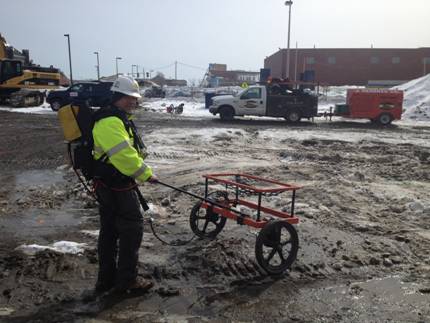Manufactured by Geonics, Inc., the EM-61 is a time-domain electromagnetic instrument was developed to find unexploded ordinances (UXOs) and other buried metal targets in environments where there may be a lot of interference from surface metal and overhead power lines. According to tests conducted by the manufacturer and reports from other geophysical service providers, the EM-61 (shown below) has a sensitivity sufficient to detect metal objects as small as a few centimeters.
The EM-61 operates on the principle that the time-decay rate (i.e. transient pulse) of a signal induced in metal decays proportionally to the mass of the metal object. The EM-61 works by generating an EM signal of known frequency and voltage at the transmitter, located in the backpack configuration. In the presence of metal objects, an EM signal is induced when the transmitted signal is applied. When the transmitter is switched off, the induced field decays at a rate specific to the metal mass in which it is induced. The EM-61 top and bottom receiver coils measure the decay voltage at a specific time (i.e.time gate) after the transmit pulse has been shut off. The amplitude of the voltage after the transmit pulse has been shut off is proportional to the size of the metal object: the larger the voltage (as measured in millivolts) at the time of the measurement, the larger the metal object. High voltages indicate metal objects. Negative voltages can also indicate both above-ground and buried metal. RSI's EM-61 Mrk2 measures the voltages at four different time-gates, which helps determine burial depth and size of the target. The larger targets have larger induced voltages at the later time-gates.
The EM-61 operates by pulling or pushing the instrumentation along survey lines spaced 5 feet apart. Data can be collected using an encoder or "DMI" - distance measurement instrument, which is built into the EM-61's left wheel, or on a time-basis. A sub-meter accuracy GPS system can also be interfaced with the EM-61, thus eliminating the need and expense to construct a survey grid. The station spacing varies, depending upon the application.
Several different data sets are generated from the two measurements made at top and bottom receiver coils and at the four different time-gates. Differential measurements, obtained from subtracting the bottom receiver coil measurements from the top, help determine whether the anomaly is caused by above or below ground sources. Differential data are used to can also minimize the response from at or very near surface (i.e. 1 cm deep or less) metal. Positive voltages in the differential contour map shown in red, magenta, and pink, indicate buried metal. Blue or black filled contours indicate above-ground sources of metal. While differential and noise measurements help reduce EM noise from adjacent power lines, cell phone and radio towers, etc., the may not eliminate them completely. Therefore, in urban environments, data may appear noisy and not have a lot of continuity. For maximum sensitivity, the EM-61 meter should be calibrated in an area free of buried metal and overhead power lines. In many urban sites, the EM-61 instrument may not be able to be calibrated due to significant sources of noise.
